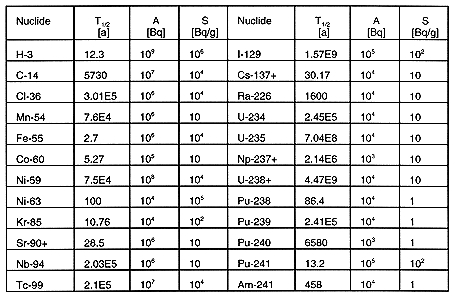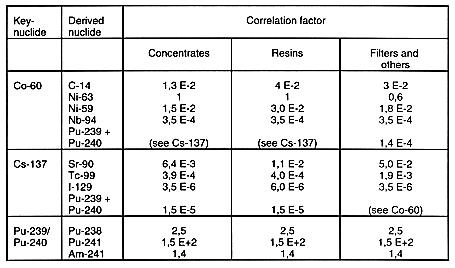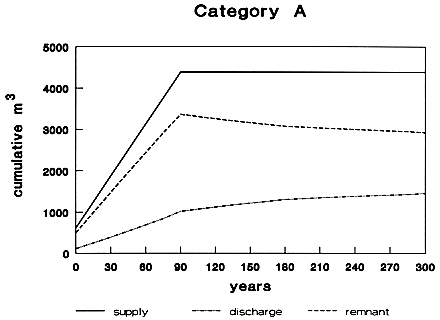
LONG TERM SURFACE STORAGE OF LOW LEVEL WASTE
L.C. Scholten, H.W. de Wit
KEMA NUCLEAR
Arnhem, the Netherlands
H.K.D. Codée, J. Welbergen
N.V. COVRA
Vlissingen, the Netherlands
ABSTRACT
In most countries radioactive waste is isolated from the biosphere by shallow land disposal or geologic disposal in rock, salt or clay. These are costly solutions. By radioactive decay the hazard of radioactive waste decreases with time. After a certain time span the waste may be declared as 'not radioactive' and hence may be disposed of in a conventional way. Recently, the European Commission has issued new exemption levels for radioactive materials. The greater part of the radioactive waste produced in nuclear power plants consists of Co-60 and Cs-137, with relatively short half-lives. Also the half-life of the natural occurring radionuclide Pb-210 is with 22.3 years relatively short. Waste contaminated with these nuclides will no longer be hazardous after some centuries.
We have studied the possibilities of storing low level waste for 300 years above ground in storage buildings. Underground disposal, shallow land or geologic, is then not necessary for the greater part of the waste.
INTRODUCTION
Radioactive waste is harmful for man and environment. However, if the activity concentration in the waste is very low, the risks can be acceptable. For a great number of anthropogenic and natural nuclides in low level waste the half-life is relatively short. This means that in a few centuries the radioactivity will be decreased to below the level of regulatory concern. Isolating from the biosphere is not necessary then and waste may be disposed of in a normal way or may be re-used. In the European Union new limits have recently been established for nuclide specific reporting levels for radioactivity. These limits will be explained.
The low level radioactive waste from nuclear power plants consists by activity of approximately 90% of Co-60 (t½=5.27 a), 9% of Cs-137 (t½=30.17 a) and 1 % of other nuclides. Within one century the Co-60 activity becomes insignificant, for Cs-137 this period is about 300 years.
In The Netherlands, COVRA is the centralized organization for the collection, treatment, storage and disposal of all kinds of radioactive waste. The company will store the radioactive waste for an interim period of at least 100 years. During this period a final disposal option should have been found. At COVRA the (Very) Low and Intermediate Level Waste is conditioned in steel drums and concrete containers which are stored in closed concrete storage buildings. Besides waste from the nuclear industry also waste from a nearby phosphorus plant will be stored which waste contains the naturally occurring radionuclides Pb-210 (t½=22.3 a) and Po-210 (t½=138 d).
A study has been set up in the Netherlands to explore the possibilities and advantages of prolonging the surface storage up to 300 years. During this extended storage time more than 80% of the activity will have decayed to below the reporting levels in the European Union and may then be disposed of as common waste. The remaining part is mainly a -containing waste. So, the volume of the waste for final geologic disposal is substantially decreased. The study has shown that there are no technical limitations.
It has already been decided to store the waste from the phosphorus plant on surface for a period of 150 years. Then the activity will have decayed by a factor of approximately 100. The remaining material can than be declared as non-radioactive (chemical) waste.
EXEMPTION / CLEARANCE LEVELS
All materials and goods contain radioactive nuclides, mostly in very low concentrations. Limits are therefore set by authorities below which the materials and goods are not subject to regulatory control as the risks related to the incorporated radioactivity are very low and acceptable. On 13 May 1996 the European Commission issued a directive with new Basic Safety Standards (BSS) for protection of the public against the dangers of ionizing radiation [1]. Within four years (i.e. before 13 May 2000) this new BSS must be incorporated into the national laws of the Member States of the European Union.
In this directive a table is given for a great number of nuclides with exemption levels under which reporting is not required. These exemption levels are given in absolute activity and specific activity. Both limits must be exceeded before regulatory control is imposed. A selection of important nuclides for the nuclear industry from the directive is given in Table I.
Table I. Exemption levels according European regulations [1] for important nuclides

The BSS states that clearance levels for waste have to be set by the national authorities. Although reporting levels are not necessarily the same as clearance levels, it is evident that both levels will be of the same order. The clearance levels under the new BSS are not yet established. For the moment we assume that they will be identical to the exemption levels listed in the BSS. With this assumption we can judge per waste package whether a waste package has decayed to a level where discharge as non-radioactive waste is acceptable.
The radioactive composition of nuclear waste can be characterized on some key-nuclides and with correlation factors to other nuclides. The key-nuclides are relatively easy measurable. As a rule of thumb the ratio between the nuclides is 90 % Co-60, 9 % Cs-137 and 1 % others. The BSS states that for a mixture of nuclides the weighted sum has to be taken according to the formulas
![]()
ai = real activity of nuclide i [Bq]
Ai = value A from the directive for nuclide i
![]()
ai = real activity in the package of nuclide i [Bq]
G = weight of the package [kg]
Si = value S from the directive for nuclide i
When using key-nuclides, these calculations have to be made with the correlation factors. In a publication from Belgium [2] a software program is described with which correlation factors can be calculated. Table II gives correlation factors for the Belgian PWR's.
Table II. Key-nuclides and examples of correlation factors for Belgian PWR's

INVENTORY OF THE WASTE
In the Netherlands there is one central organisation, COVRA, for collecting, handling and storage of radioactive waste. The facilities are located in the outermost south-west part of the country. From 1982 on all radioactive waste produced in the Netherlands has been stored at the COVRA site in above ground storage facilities. From the start of the storage complex the waste producers had to provide the inventory of radioactive nuclides in each package. After conditioning each drum got a unique identification number. From the data-base it can be calculated at which date the specific activity for each drum will fall under the exemption level given in the BSS.
For the volumes and activities of future waste the historical trend from the last five years was extrapolated. The cumulative volumes for category A waste (a -active waste) and category B (waste from nuclear power plants) are given in Figure 1 and 2

Fig. 1. Cumulative volumes of delivery and transport of category A waste in the Netherlands

Fig. 2.Cumulative volumes of delivery and transport of category B waste in the Netherlands
In COVRA's present planning the collect and storage of waste for a period of at least 100 year is foreseen. One can assume that the supply of category A waste will stop 90 year from now. It is the expectation that nuclear shut-down in the Netherlands will be completed in 2005. The supply of category B waste will stop then.
From figure 1 it can be seen that from the category A waste only about 1/3 may be disposed of within 300 years. This is not remarkable because most a -active nuclides have half-lives (much) longer than 300 years. However, the category B waste has decayed almost completely and may be disposed of as non-radioactive waste. A same exercise was done for waste coming from other institutions (hospitals etc.). Of the total volume of waste supplied in 100 years only about 15% remains radioactive after 300 years, a remarkable reduction.
Before discharge it is always possible to check on a non-destructive way the content of a package. The absolute activity and specific activity for the key-nuclides Co-60 and Cs-137 can be measured with a Ge-detector on the outside. Several systems have been developed to check the correlation factors for complete drums [3]. The clearance levels can be measured in a reasonable counting time on the key-nuclides [4].
TECHNICAL LIFE EXPECTANCY
Before deciding to expand the storage time to 300 years, one has to be sure that the containers and the facilities remain intact during such a long period. A number of studies have been done on the integrity of steel drums at near-surface disposal. Some studies for nuclear waste give results for storage conditions comparable to those at COVRA [5,6]. From these studies and experiences from general corrosion studies it could be concluded that the integrity of the steel drums at COVRA will maintain for 300 years. Also studies for concrete show that deterioration of concrete over 300 years will not impact the integrity of containers.
The life-time expectancy for the storage buildings has been estimated. The as-build condition of the storage buildings are well-known. Provided regular maintenance a life-time of 300 years can be guaranteed.
A special problem arises when global warming persists. The premises of COVRA are near the sea coast and 5 meter above normal sea level. A rise of the sea level of some meters is not inconceivable [7], which increases the risk of flooding of the site. When raising of sea level becomes a reality then protective measures have to be taken. With the construction of dikes the Dutch have great experience. In the outmost case the waste has to be removed to a higher located site.
CONCLUSIONS
Radioactive waste decays with time and it can be predicted exactly how long it remains hazardous. By volume, the hazard for the greater part of the waste decays in some centuries to acceptable risks. It is shown that it is possible to store this greater part on land for a long time, so that geologic disposal can be avoided.
The advantages are:
Surface storage has to be considered as a real and pragmatic option for disposal of low radioactive waste.
REFERENCES